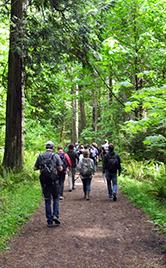Esquimalt Lagoon Watersheds
The watershed that drains into Esquimalt Lagoon is about 1850 hectares in size. There are three main creeks that enter the lagoon: Colwood, Bee and Selleck creeks. A series of smaller spring-fed creeks also enter the lagoon, from groundwater flows originating beneath the loose gravel sediments along the escarpment above the lagoon. Bee and Selleck creeks both arise from these gravel sediments, and Colwood Creek drains a much larger upstream area.
Colwood Creek
 The largest watershed that drains into Esquimalt Lagoon is Colwood Creek, at 850 hectares. From headwaters at Humpback Reservoir, the watershed includes rocky hills, lush forested land, lakes, wetlands, residential and urban areas, a community park and a golf course. The lower reaches of Colwood Creek flow through Royal Roads University lands before emptying into Esquimalt Lagoon.
The largest watershed that drains into Esquimalt Lagoon is Colwood Creek, at 850 hectares. From headwaters at Humpback Reservoir, the watershed includes rocky hills, lush forested land, lakes, wetlands, residential and urban areas, a community park and a golf course. The lower reaches of Colwood Creek flow through Royal Roads University lands before emptying into Esquimalt Lagoon.
Bee Creek
Bee Creek is a small, spring-fed stream that begins as groundwater seepage at the base of a rock escarpment on Royal Roads University grounds. The stream flows through young forest and shrubs, then through the lawns and gardens on the Havenwood property before discharging into Esquimalt Lagoon in a small estuary. Bee Creek watershed contains some ancient Coastal Douglas-fir forest, residential areas and open fields that were once farmed. Unlike most streams, the flows in Bee Creek do not change much with the seasons since it is fed by groundwater more than by rainwater. This unique characteristic makes this small creek critically important to salmonids as there is continuous flow of cool water during the spawning season.
Click here for more information about Bee Creek and the work of volunteers in monitoring cutthroat trout.